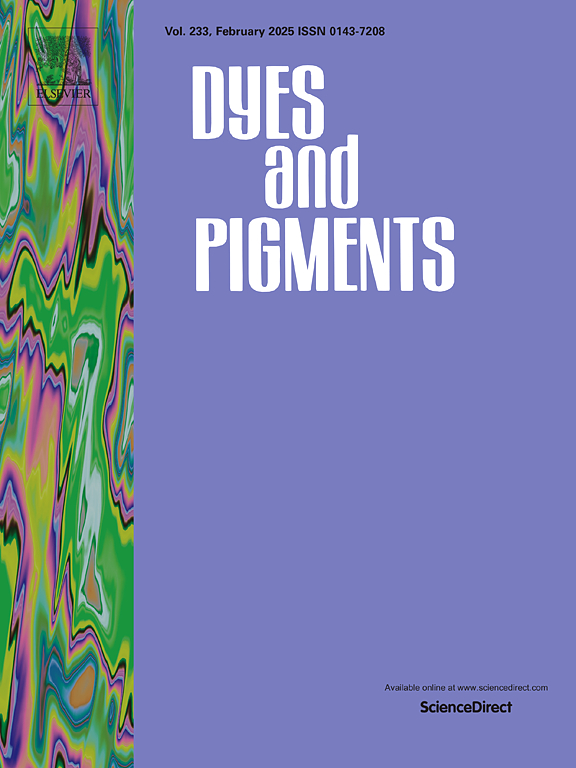Force-, acid- and photo-triggered fluorescent switching behaviors and applications of acylhydrazide derivative
IF 4.1
3区 工程技术
Q2 CHEMISTRY, APPLIED
引用次数: 0
Abstract
A carbazole-substituted triphenylamine-based acylhydrazone derivative (TPCZ) was synthesized, TPCZ exhibited mechanical force, acid, and light-responsive properties. Firstly, TPCZ exhibited mechanofluorochromic properties, the fluorescence emission switching from cyan to green after grinding. The change in emission was attributed to a crystalline-amorphous phase transition. Secondly, due to the protonation of –HC![]() N- in TPCZ, TPCZ exhibited acidochromism, the color of a TPCZ film changed from slight yellow to orange under visible light, and the blue emission quenched under UV light upon fumigation with trifluoroacetic acid (TFA), and the fluorescence can be reversibly switched on and off upon reaction with TFA and triethylamine (TEA). Furthermore, TPCZ displayed photo-induced quenching phenomena, and the main reason for the quenching of fluorescence was that TPCZ underwent a trans-cis isomerization upon photo-irradiation. These foregoing stimuli responsive behaviors revealed that TPCZ may possess enormous potential application value in sensing, security label and anti-counterfeiting.
N- in TPCZ, TPCZ exhibited acidochromism, the color of a TPCZ film changed from slight yellow to orange under visible light, and the blue emission quenched under UV light upon fumigation with trifluoroacetic acid (TFA), and the fluorescence can be reversibly switched on and off upon reaction with TFA and triethylamine (TEA). Furthermore, TPCZ displayed photo-induced quenching phenomena, and the main reason for the quenching of fluorescence was that TPCZ underwent a trans-cis isomerization upon photo-irradiation. These foregoing stimuli responsive behaviors revealed that TPCZ may possess enormous potential application value in sensing, security label and anti-counterfeiting.
酰基肼衍生物的力、酸和光触发荧光开关行为及其应用
合成了一种咔唑取代三苯胺基酰基腙衍生物(TPCZ), TPCZ具有机械力、酸和光响应性能。首先,TPCZ表现出机械致荧光特性,经过研磨后荧光发射由青色转变为绿色。发射的变化归因于结晶-非晶相变。其次,由于- hcn -在TPCZ中的质子化作用,TPCZ呈现酸致变色,在可见光下TPCZ薄膜的颜色由淡黄色变为橘黄色,三氟乙酸(TFA)熏蒸后TPCZ薄膜的蓝光在紫外光下猝灭,与TFA和三乙胺(TEA)反应后荧光可以可逆地开启和关闭。此外,TPCZ还表现出光致猝灭现象,荧光猝灭的主要原因是TPCZ在光照射下发生了反顺异构化反应。上述刺激反应行为表明,TPCZ在传感、防伪标签和防伪等方面具有巨大的潜在应用价值。
本文章由计算机程序翻译,如有差异,请以英文原文为准。
求助全文
约1分钟内获得全文
求助全文
来源期刊

Dyes and Pigments
工程技术-材料科学:纺织
CiteScore
8.20
自引率
13.30%
发文量
933
审稿时长
33 days
期刊介绍:
Dyes and Pigments covers the scientific and technical aspects of the chemistry and physics of dyes, pigments and their intermediates. Emphasis is placed on the properties of the colouring matters themselves rather than on their applications or the system in which they may be applied.
Thus the journal accepts research and review papers on the synthesis of dyes, pigments and intermediates, their physical or chemical properties, e.g. spectroscopic, surface, solution or solid state characteristics, the physical aspects of their preparation, e.g. precipitation, nucleation and growth, crystal formation, liquid crystalline characteristics, their photochemical, ecological or biological properties and the relationship between colour and chemical constitution. However, papers are considered which deal with the more fundamental aspects of colourant application and of the interactions of colourants with substrates or media.
The journal will interest a wide variety of workers in a range of disciplines whose work involves dyes, pigments and their intermediates, and provides a platform for investigators with common interests but diverse fields of activity such as cosmetics, reprographics, dye and pigment synthesis, medical research, polymers, etc.
 求助内容:
求助内容: 应助结果提醒方式:
应助结果提醒方式:


